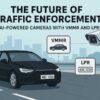Ensuring road safety by enforcing speed limits and deterring dangerous driving habits has been a significant challenge for cities worldwide. Choosing between fixed traffic enforcement cameras and portable traffic cameras can be a daunting task.
Both camera systems offer distinct benefits. Let’s discuss the pros and cons of these enforcement systems to help you adopt the right approach for your city.

What is a Fixed Traffic Enforcement Camera?
Fixed cameras have multi-tracking radar, other high-resolution sensors, and ANPR software for real-time license plate detection. Usually, authorities install them on existing traffic infrastructure, such as poles. They cover a specified, large area of traffic across multiple lanes.
Benefits of Fixed Cameras
- Fixed traffic cameras operate around the clock, detecting violations and capturing vehicle license plates in real-time.
- Authorities can choose the placement of fixed cameras with a data-driven approach. They can analyze traffic patterns, accident history, and frequency of violations in specific busy or accident-prone zones.
Limitations of Fixed Traffic Cameras
- Fixed camera systems are stationary, covering a specific area of traffic. Yet, they leave other problem areas uncovered and unchecked.
- Fixed traffic enforcement cameras may be ‘predictable’ for drivers who know their locations. In such cases, drivers may adjust their behavior when they are under surveillance but continue to engage in risky driving elsewhere.
What is a Portable Speed Camera?
Police mobile cameras are not permanently mounted in one place, but are portable; they can be installed in vehicles, temporary poles, and trailers. The unit features sensors and radar, as well as optional LED and infrared capabilities, allowing it to operate efficiently even in adverse lighting and weather conditions, and to detect violations in real-time.
Advantages of Deploying Mobile Speed Cameras
- You can flexibly relocate a portable speed camera to high-traffic areas, such as schools, construction zones, event venues, and accident-prone clusters, where you expect temporary heavy traffic.
- The portability of mobile speed cameras helps ensure effective traffic enforcement across various parts of the city.
- You can deploy Portable speed cameras almost anywhere, making them ‘unpredictable’ for drivers. So, drivers are more likely to follow speed limits and other traffic regulations.
Limitations of Portable Traffic Cameras
- Mobile speed cameras cannot monitor a specified area around the clock, unless they are powered by a solar panel system..
- Skilled traffic staff can move them to the desired location and carry out setup and installation.
Adopting a Hybrid Approach for Efficient Enforcement
As there is no ‘one-fits-all’ formula, cities need to mix and match enforcement camera types to ensure efficiency with available resources. Rather than making it an either/or decision, it is wise to combine the consistent monitoring capabilities of fixed traffic enforcement cameras with the flexibility and adaptability of portable traffic cameras.
To implement the vision of innovative, safer, and efficient traffic networks, cities can:
- Deploy fixed cameras to safeguard permanent danger zones, such as schools, accident-prone areas, and high-traffic locations.
- Utilize police mobile cameras to rotate across multiple problem locations, addressing fluctuating enforcement needs.
By adopting this layered approach, cities enhance community trust as enforcement will be efficient, data-driven, widespread, and fair in all respects.
FAQs
You can install fixed cameras on existing traffic infrastructure, like a pole. They monitor a specified area continuously. You can relocate mobile speed cameras to multiple locations based on area-specific enforcement needs.
Yes. As you can place portable traffic cameras almost anywhere, making them ‘unpredictable’ for drivers, they usually make drivers remain alert in all areas and drive safely, respecting the traffic regulations.
Yes. Modern police mobile cameras have infrared capabilities and high-resolution sensors. They can effectively operate even at night and in adverse weather conditions.
For smaller cities, portable speed cameras can be cost-effective, as they can be moved to multiple locations. So, fewer units could cover different areas alternately. However, adding a few fixed traffic enforcement cameras helps yield the best results in the long run.
Cities need to analyze traffic patterns, accident data, and consider community feedback to ensure safety-focused enforcement rather than revenue-driven enforcement.


